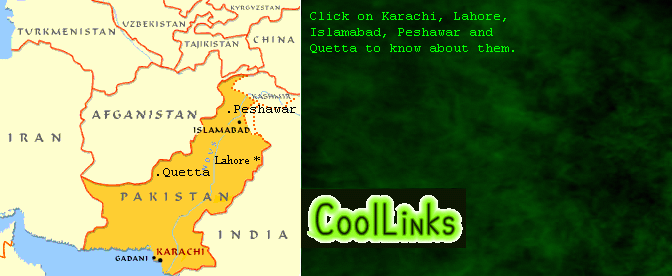


GENERAL
|
Population: |
135,135,195 (July 1998 est.) |
| Population growth rate: | 2.2% (1998 est.) |
| Birth rate: | 34.38 births/1,000 population (1998 est.) |
| Death rate: | 10.69 deaths/1,000 population (1998 est.) |
| Sex ratio: | at
birth: 1.05 male(s)/female under 15 years: 1.06 male(s)/female 15-64 years: 1.05 male(s)/female 65 years and over: 0.99 male(s)/female (1998 est.) |
| Infant mortality rate: | 93.48 deaths/1,000 live births (1998 est.) |
| Total fertility rate: | 4.91 children born/woman (1998 est.) |
| Life expectancy at birth: | total
population: 59.07 years male: 58.23 years female: 59.96 years (1998 est.) |
| Literacy: | definition: age 15 and over can read and write total population: 37.8% male: 50% female: 24.4% (1995 est.) |
| Religions: | Muslim 97% (Sunni 77%, Shi'a 20%), Christian, Hindu, and other 3% |
| Nationality: | noun: Pakistani(s) adjective: Pakistani |
| Languages: | Punjabi 48%, Sindhi 12%, Siraiki (a Punjabi variant) 10%, Pashtu 8%, Urdu (official) 8%, Balochi 3%, Hindko 2%, Brahui 1%, English (official and lingua franca of Pakistani elite and most government ministries), Burushaski, and other 8% |
| Government | |
|---|---|
| Country name: | conventional long form: Islamic Republic of Pakistan
conventional short form: Pakistan former: West Pakistan |
| Data code: | PK |
| Government type: | federal republic |
| National capital: | Islamabad |
| Independence: | 14 August 1947 (from UK) |
| National holiday: | Pakistan Day, 23 March (1956) (proclamation of the republic) |
| Legal system: | based on English common law with provisions to accommodate Pakistan's status as an Islamic state; accepts compulsory ICJ jurisdiction, with reservations |
| Suffrage: | 21 years of age; universal; separate electorates and reserved parliamentary seats for non-Muslims and tribal areas |
| Judicial branch: | Supreme Court, judicial chiefs are appointed by the president; Federal Islamic (Shari'at) Court |
| Flag description: | green with a vertical white band (symbolizing the role of religious minorities) on the hoist side; a large white crescent and star are centered in the green field; the crescent, star, and color green are traditional symbols of Islam |
| Economy | |
|---|---|
| GDP: | purchasing power parity—$344 billion (1997 est.) |
| GDP - real growth rate: | 3.1% (1997 est.) |
| GDP - per capita: | purchasing power parity—$2,600 (1997 est.) |
| GDP - composition by sector: | agriculture: 24.2% industry: 26.4% services: 49.4% (1997) |
| Inflation rate - consumer price index: | 11.8% (FY96/97) |
| Labor force: | total: 37.8 million (1998) by occupation: agriculture 47%, mining and manufacturing 17%, services 17%, other 19% note: extensive export of labor, mostly to the Middle East, and use of child labor |
| Unemployment rate: | NA% |
| Budget: | revenues: $9.6 billion expenditures: $13.6 billion, including capital expenditures of $NA (FY96/97) |
| Industries: | textiles, food processing, beverages, construction materials, clothing, paper products, shrimp |
| Industrial production growth rate: | 3.3% (FY96/97 est.) |
| Agriculture - products: | cotton, wheat, rice, sugarcane, fruits, vegetables; milk, beef, mutton, eggs |
| Exports: | total
value: $8.2 billion (FY96/97) commodities: cotton, textiles, clothing, rice, leather, carpets partners: EU, US, Hong Kong, Japan |
| Imports: | total
value: $11.4 billion (FY96/97) commodities: petroleum, petroleum products, machinery, transportation equipment, vegetable oils, animal fats, chemicals partners: EU, Japan, US, China |
| Debt - external: | $33 billion (1997 est.) |
| Transportation | |
|---|---|
| Railways: | total: 8,163 km |
| Highways: | total: 224,774 km |
| Pipelines: | crude oil 250 km; petroleum products 885 km; natural gas 4,044 km (1987) |
| Merchant marine: | total: 24 ships (1,000 GRT or over) totaling 416,875
GRT/684,580 DWT ships by type: bulk 5, cargo 15, container 3, oil tanker 1 (1997 est.) |
| Ports and harbors: | Karachi, Port Muhammad bin Qasim |